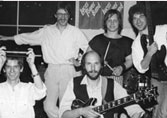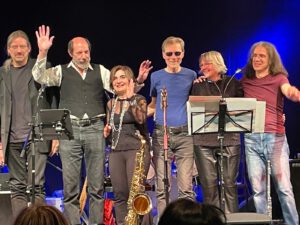There are not many bands like the Lukas Tower Band (LTB) with its unsettled history and which at the same time were almost completely ignored by the music media. This can be traced back both to the genre, “a unique and ambitious Art-Folk-Rock, based on jazz harmonies” (Record Mirror) and to the respective Zeitgeist, which was usually contrary to LTB’s musical approach. Their music aimed at cracking the Pop/Rock mainstream, which meant ending all attempts at three minute streamlined compositions with formulaic repetitions of verse/chorus structures. On the contrary, the band developed a predeliction for asymmetrical verses, the repeated use of odd meters and rhythms and lengthy, quasi psychedelic instrumental sections, mediated by intensive vocal parts. Thus, if the listener wasn’t interested in investing time actively listening and even reading the lyrics, it didn’t make good background music.

The roots of LTB go back to 1979 in the atmosphere of the University of Munich, when the students of art and psychology Fredi Orendt (keyb, b, fl), Dieter Göbel (g, voc) and Frank Otto (dr) invited their fellow student Wolfgang Fastenmeier (g) to jam sessions, starting with lightweight Pop/Rock efforts. Things changed when Göbel disappeared to the far east mantra and Fastenmeier and Orendt moved in a completely different musical direction by developing more ambitious songs. First they were influenced by Folk and Prog heroes such as Jethro Tull, Steeleye Span, Pink Floyd or Camel, but later they created their own brandmark of music – first under the label “Rocaille”, then with the shortlived “Strange Ways”. This music was sometimes softer, sometimes more powerful, often with dark edged songs and ballads with epic flutes about minstrels, rogues, highwaymen, murder and blood feuds, unhappy love and dionysean struggles of the soul.

In typical Rock fashion some members departed after a few gigs for both private and musical reasons. In 1984 the time had come for a really new formation: Fastenmeier and Orendt took in Walter Krainz (b) and Harald Krüger (dr) and together with female vocalist Brigitte Schmidt LTB was formed. The name refers to their domicile: one of the St. Lukas church towers in Munich. Schmidt’s joining the band, endowed as she was with a voice which sounded “as if Sandy Denny had been crossed with Janis Joplin” (Folk-Rock Society) – turned out to be a stroke of luck and thus LTB could leave their mark in the world of Prog by having a female vocalist up front. Schmidt had a particular feeling for the textural eclecticism of the band: the adaptation of the poetry and the fairy tales of the British and Irish Isles set to music under the direction of Fastenmeier.
This root formation of LTB, some say the best, soon won a loyal cult following. Nevertheless, LTB were unlucky as their music was falling on deaf ears in the time of the post-punk era, the eighties with their clinical neon pop songs. After two years, Krainz called it a day, returning to Austria. But first, good replacement was found and the band saw even more potential to shape their sound by incorporating saxophone into the lineup. In 1988 Schmidt departed due to her new role as a mother, no longer interested in continuing her career. From then on the number of band members changed every three months. The band tried to integrate funk and pop elements into their music to move more into the mainstream and further away from their Prog and Folk-Rock roots, hoping for radio time. It was a misguided plan, as it displayed only a very streamlined version of all the elements that made LTB unique. It resulted in “a sticky Soft-Rock amalgam with thin lyrics” (Progressive News), a situation that culminated in the early nineties. Fastenmeier and Orendt devoted themselves to other projects, leaving the band reeling in a musical Nirvana and it seemed only a question of time before LTB would quit.
So much more surprising then, was the comeback of the band, highlighted as newcomer (!) of the year 2000 by Grooveme Records. The band now consisted of Fastenmeier (g), Orendt (keyb, fl), Gerhard Heinisch (b), Albrecht Pfister (sax, fl), completed by ex-hard rocker Thomas Willecke on drums and the expressive female vocalist Angela Maier, originally based on the jazz tradition, and supplemented by varying guest musicians. Today, “the vital and rejuvenated veterans” are able “to return musically to their starting point of their unique Prog-Rock in a folky and jazzy vein” (Prog World).
In consequence in 2004 the album „After Long Years“ came into light, which thematically harked backed to the past of the band and – although it marked some kind of transitional phase – could be seen as a prototypical LTB-album. Their “felicitous mix of Progressive Rock elements with Jazz” was critically acclaimed (Besonic) and labelled as “Symphonic Rock with Folk- and Jazzelements” (Musea Records) or as “an exceptional album for the year 2004 with a progressive Rock-Folk-Jazz-melange, sexy female vocals, lot’s of flutes and sax and a beautiful mix of elegiac music with fabulous lyrics” (Milestones in Rock). Even comparisons to legends such as King Crimson, van der Graf Generator or Curved Air were applied. Thanks to the now gained personal stability the band developed further to a perfectly harmonizing ensemble. As Pfister (sax) left the band to concentrate solely on his jazz projects, this smoothed the way for Fastenmeier’s plan to strenghten the folky character of the band: soon Ursula Wilpert on low and high whistles and Sylvia Szekely on violin joined the band. On the occasion of their 25th anniversary the band released 2010 the album “ALBEDO”, which was celebrated as “one of the best new Folk-Prog releases” (Ohrwaschl). Indeed, the album presents a unique blend of folk and progressive rock with lively jig- and reeltype songs of celtic provenance, freewheeling and relaxed Jazzrock à la early Caravan, electric guitars and keyboards are intermingled with acoustic guitars and plenty of flute and violin, generating atmosphere as if Andy Latimer and Peter Bardens are passing by for a jamsession, – not to forget the world music influences (Babyblaue Seiten). Nevertheless, the band’s development boosted as they succeeded to engage Luluk Purwanto, a world-class jazz violinist: With Purwanto came a dervish on violin with an exotic-extroverted stage-presence which shaped the band’s sound and musical approach even more: as basis some kind of Art-Folk-Rock of anglosaxon type, but in texture played like progressive rock with multipart, suitelike structures and yet spontaneous and lenghty psychedelic-jazzy improvisations, mediated by the harmonic complexity of the songs. Thus, this may bring about that those, who wish to strictly pigeon-hole musicians into distinct genres, will be confused: LTB may be too folky and jazzy for hard core prog fans, especially as the usual heavy metal-like guitar attacks are missing, yet too rocky for folk purists. In the beginning of 2013 longtime bass player Gerhard Heinisch had to quit for health reasons. At the same time, former bass player (from 1987/88!) Timm Bahner was searching for new musical challenges – and returned to the band’s delight. Although he often somewhat amused takes note of Fastenmeier’s repeated use of odd meters and rhythms and the complex structure of the songs, he is significantly responsible for the grooviness of the songs. The concert film “LTB – Live in Concert” from 2014 displays the hitherto best LTB-line-up in the videotaping of an intimate club performance. It reveals not only a perfectly and well-rehearsed ensemble, but also how different studio- and live versions of songs can be presented. And it is the performance of a band which is usually more obliged to atmosphere and euphony and which is at the same time rough, playful and spontaneous.
Addendum 2024
 10 years later, we find a completely revitalized band. Singer Paola Ottaviani, who originally comes from the Italian pop scene, has worked her way into the somewhat twisted LTB style and the associated wide tone spreading with verve and also takes the live concerts to a new level with her stage presence. Regina Willecke enchants with her flute playing, from the romantic beauty of the ballads to the overblowing technique made so famous by jazz musician Roland Kirk. Her jazz-oriented use of the saxophone adds a further timbre.
10 years later, we find a completely revitalized band. Singer Paola Ottaviani, who originally comes from the Italian pop scene, has worked her way into the somewhat twisted LTB style and the associated wide tone spreading with verve and also takes the live concerts to a new level with her stage presence. Regina Willecke enchants with her flute playing, from the romantic beauty of the ballads to the overblowing technique made so famous by jazz musician Roland Kirk. Her jazz-oriented use of the saxophone adds a further timbre.
With the versatile Markus Lamek on keyboards, who is well-known in the prog scene, LTB have succeeded in incorporating congenial sounds and keyboard arrangements into their music, which is also reflected in the current album “A Prophecy”, produced to mark the band’s 40th anniversary. Last but not least, Miguel Pires joined the band on bass, an equally accomplished and creative musician whose ability to play to the point never ceases to amaze. Incidentally, “A Prophecy” can be described as LTB’s magnum opus to date, because it succeeded in creating a live-like atmosphere in the tracks in the studio as well.
Exzerpts from:
– Paul Burglar (2000). A Comprehensive History of Rock. Edinburgh University Press.
– Causse de la Selle (2015). Hidden Gems in Contemporary Music. Blakes Online-Music-Press.
(Dtsch. Übersetzung: Geralt Sattelbieger).
